

Arousal Control in Sport - Oxford Research Encyclopedia of Psychology. Allred, K.

D., & Smith, T. W. (1989). The hardy personality: Cognitive and physiological responses to evaluative threat. Journal of Personality & Social Psychology, 56(2), 257–266.Find this resource: Arousal & Performance. Arousal is a major aspect of many learning theories and is closely related to other concepts such as anxiety, attention, agitation, stress, and motivation.
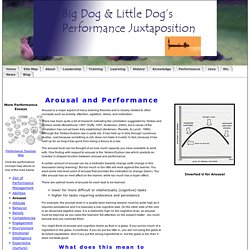
There has been quite a bit of research indicating the correlation suggested by Yerkes and Dodson exists (Broadhurst, 1957; Duffy, 1957; Anderson, 2000), but a cause of the correlation has not yet been fully established (Anderson, Revelle, & Lynch, 1989). Although the Yerkes-Dodson law is quite old, it has held up in time through numerous studies.
Just because something is old, does not make it invalid. In fact, because it has held up for so long it has gone from being a theory to a law. The arousal level can be thought of as how much capacity you have available to work with. Arousal and Performance - Sportlyzer Academy. Arousal is the key issue in sport psychology.
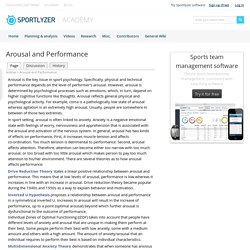
Specifically, physical and technical performance depends on the level of performer’s arousal. Drive Reduction Theory - Psychestudy. Inverted U hypothesis - Sportlyzer Academy. The Inverted U Hypothesis suggests that optimal performance occurs at an intermediate level of arousal while both low and high levels of arousal will result in impaired performance.
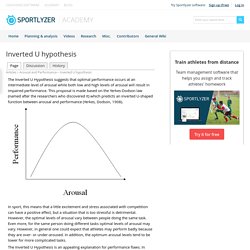
This proposal is made based on the Yerkes-Dodson law (named after the researchers who discovered it) which predicts an inverted U-shaped function between arousal and performance (Yerkes, Dodson, 1908). In sport, this means that a little excitement and stress associated with competition can have a positive effect, but a situation that is too stressful is detrimental. However, the optimal levels of arousal vary between people doing the same task. The Inverted-U Model - Stress Management From MindTools.com. (Also known as Yerkes-Dodson Law) Have you ever worked on a project that had a tight-but-achievable deadline, and that needed your unique, expert knowledge for it to be completed successfully?
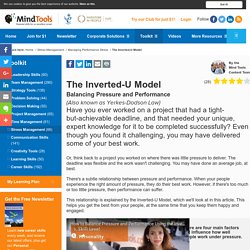
Even though you found it challenging, you may have delivered some of your best work. Or, think back to a project you worked on where there was little pressure to deliver. The deadline was flexible and the work wasn't challenging. You may have done an average job, at best. There's a subtle relationship between pressure and performance.
This relationship is explained by the Inverted-U Model, which we'll look at in this article. There are four main factors that influence how well people work under pressure. About the Model The Inverted-U model (also known as the Yerkes-Dodson Law), was created by psychologists Robert Yerkes and John Dodson as long ago as 1908. Catastrophe Model of Anxiety - Sportlyzer Academy. The Catastrophe Model of Anxiety proposes four specific relationships between cognitive anxiety, physiological arousal and performance (Hardy, 1990, 1996): Cognitive anxiety (worry) has a positive linear relationship with performance when physiological arousal is low (see Figure); 2.
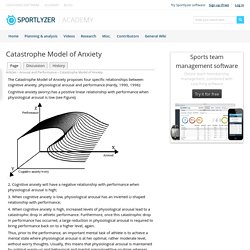
The Relationship between of positive emotion and sp ort competitions in expert’s athletes. Regulating Athletes' Emotions - Coaches Association of OntarioCoaches Association of Ontario. What are some strategies you use to regulate athletes’ emotions?
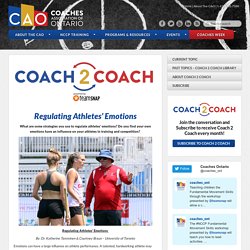
Do you find your own emotions have an influence on your athletes in training and competition? Regulating Athletes’ Emotions By: Dr. Katherine Tamminen & Courtney Braun – University of Toronto Emotions can have a large influence on athlete performance. There are a variety of strategies and approaches that coaches might use to try and increase the positive emotions or decrease the negative emotions of their athletes. Lazarus 2000. An overview of mood and emotions in sport - USQ ePrints.
Terry, Peter C. (2003) An overview of mood and emotions in sport.

In: 4th Asia-South Pacific Association of Sport Psychology International Congress, July 2003, Seoul, Korea. There is no doubt that sport generates powerful emotional responses among participants and spectators alike. The sight of soccer teams and their supporters overwhelmed by euphoria or reduced to despair during the 2002 World Cup is ample testament to this fact. There is also strong anecdotal and scientific evidence that emotions experienced by athletes prior to and during sport performance have a profound effect upon the quality of their performances (see Hanin, 2000). The purpose of this paper is to explore the link between emotional responses and sport performance.The first section addresses conceptual issues, in particular the distinction between the related constructs of emotion and mood; and presents some of the conceptual models put forward by theoreticians.
Britishcycling.org. Interview Jekauc 2016. Sports: The Power of Emotions. At the top of the Prime Sport Pyramid sits emotions.

It's closest to the top of the pyramid (above motivation, confidence, intensity, and focus) because emotions will ultimately dictate how you perform throughout a competition. Emotions during a competition can cover the spectrum from excitement and elation to frustration, anger, and disappointment. Emotions are often strong and, most troublesome, they can linger and hurt your performances long after you first experience them. Negative emotions can hurt performance both physically and mentally. They first cause you to lose your prime intensity. Negative emotions can also hurt you mentally. Emotions come from past experiences in similar athletic situations in the form of beliefs and attitudes you hold about performing and competing. Negative emotions can be provoked by many occurrences during a competition including bad calls, senseless mistakes, making an error at a crucial point in the competition, and just performing poorly. Anxiety. Anxiety is more than just feeling stressed or worried.
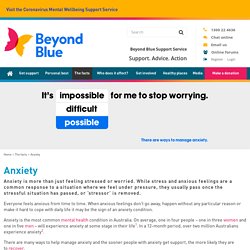
While stress and anxious feelings are a common response to a situation where we feel under pressure, they usually pass once the stressful situation has passed, or ‘stressor’ is removed. Anxiety is when these anxious feelings don't go away – when they're ongoing and happen without any particular reason or cause. It’s a serious condition that makes it hard to cope with daily life. Everyone feels anxious from time to time, but for someone experiencing anxiety, these feelings aren't easily controlled. Anxiety is the most common mental health condition in Australia. Anxiety: Causes, symptoms, and treatments. Anxiety disorders. Somatic Anxiety - Treating the Body vs. the Mind. Trait and State Anxiety - Performance Anxiety - Anxiety. State vs Trait Anxiety - Difference Between. Updated on December 12, 2017 Anxiety is an acute emotion characterized by an unpleasant agitation and restlessness as a result of an overreaction to a stimulus subjectively seen as potentially dangerous.
Anxiety is often accompanied by such symptoms as increased blood pressure, increased heart rate, muscle tension, excessive sweating and rapid breathing. Anxiety can manifest itself in two recognizable ways, state or trait. State anxiety is a short-term condition. Patients suffering from trait anxiety usually experience it as a permanent psychological trait. Definitions. Points of Difference Between State and Trait Anxiety Revealed. Measures of Anxiety. Measures of anxiety: State-Trait Anxiety Inventory (STAI), Beck Anxiety Inventory (BAI), and Hospital Anxiety and Depression Scale-Anxiety (HADS-A). - PubMed - NCBI. Sport Competition Anxiety Test (SCAT) test. Artvalidacion300e. Stress and Anxiety in Athletics. By: Carly M. Fullerton Introduction. The Stress Process in Physical Education.